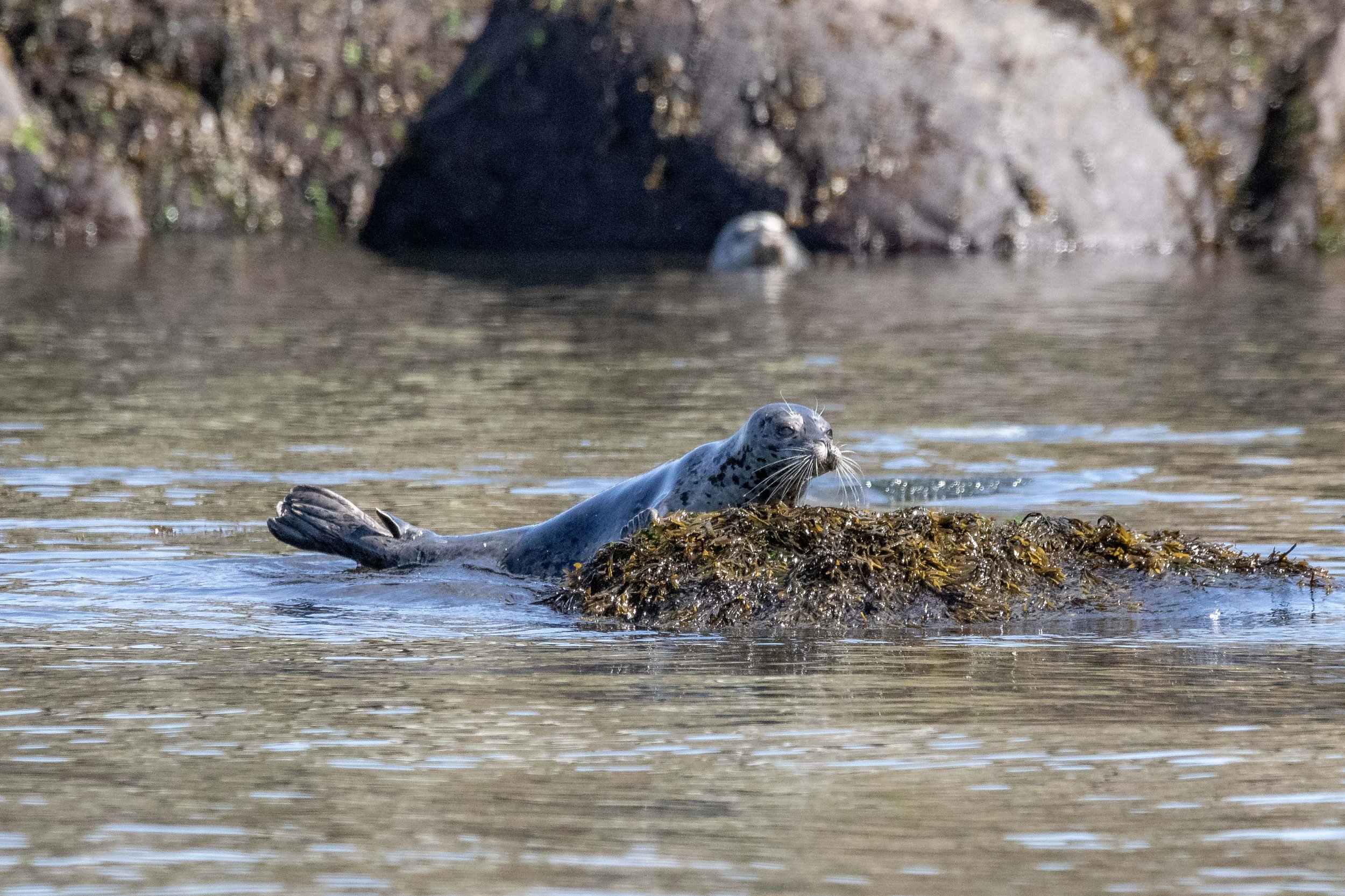March 26, 2024 - Spending time with the T124As, T124A4s, and T124A1s (with the new baby!)
It was a beautiful calm day as we had our open vessel leave the dock in Nanaimo. Before we could even round the corner of Protection Island, we got the news that there was a group of Orca that just crossed Dodd Narrows heading north. Dodd Narrows is a narrow passageway that separates Joan Point on Vancouver Island and Mudge Island, and it’s only a ten-minute boat ride from us. Of course, we headed that way to see if we would find those whales!
It didn’t take us long before we found them, 7 fast-travelling whales tend to be easy to see, especially with the calm waters. None of our whales are tagged or chipped so we find them every day just with our eyes. It’s days like these our jobs are easy! The whales we saw today were:
T124A Kittiwake ♀ (1984)
T124A6 Kasuun ♂ (2016)
T124A7 ♀ (2021)
T124A1 Bonapartes ♀ (1996)
T124A1A (2024 calf)
T124A4 ♀ Sabio (2010)
T124A4A (2021 calf)
We had stumbled upon a mini-family reunion with a new addition! This calf is supposed to belong to T124A1 Bonapartes, but they seemed to be stuck to another whales side. Instead of being in the calf position with T124A1 Bonapartes their mom, they were beside T124A4 Sabio; their aunt. Given that research has shown that dolphins (of which orca are the largest members) might not sleep for the first month after the calf is born, it could be that Bonapartes just needed a little break from the rambunctious new bundle. I’m sure many new parents can relate!
It seems like Sabio was on babysitting duty today. The calves can also be quite a handful at the beginning of their lives as they have to keep moving to stay warm as they don’t have blubber built up like the adults. That is also why the new babies appear to have an orange/pink tinge to their white, it is the circulatory system showing through the skin. This is also the first calf Bonapartes has had, so a little help from your family is always appreciated. This is also an example of how social our orca are and how they care for each other just like we do. The T002Cs, A pod that regularly frequents our waters, had a member born with scoliosis, and the family took care of him. He could not keep up with the rest so they would circle back to make sure he was in tow as well made sure he was always feed! What amazing animals.
After spending our hour with the whales we continued to see who else we could spot. We were not disappointed, we had so many different birds! We also spent some time with our Harbour Seals and their larger noisy cousins the sea lions, before making one last stop at the Gabriola Bluffs.
Please enjoy the photos taken during the trip by Marine Naturalist Vanessa Vereschahen below!
T124A1 Bonapartes usually travels alone, but with with her mom and siblings today!
Here is T124A Kittiwake, the oldest matriarch of this group of whales.
T124A6 Kasuun surfacing showing off both his eye patch and saddle patch.
T124A7 surfaces with their full saddle patch showing.
T124A4 Sabio surfaces with T124A1A in close tow.
T124A Kittiwake surfacing with her youngest, T124A7.
T124A Kittiwake doing a fast surface with her eldest daughter T124A1 Bonapartes behind her.
So many whales! Here is T124A Kittiwake in the back with T124A6 Kasuun and T124A7, and T124A1 Bonapartes in the background.
T124A1 Bonapartes making waves in the calm seas.
T124A Kittiwake can be distinguished by her saddle patch having a dark streak near the front, as well as a straight line and dot close to the base of her dorsal fin.
Likely T124A7 following T124A Kittiwake, although this is a weird angle!
T124A1 Bonapartes surfacing in front of T124A7.
A close up look at T124A1A’s face while they travel next to their Aunt T124A4 Sabio!
Aren’t they just the cutest thing you’ve ever seen?!? So squishy!
T124A7 surfacing next to mom, T124A Kittiwake.
Family photo featuring from left to right, T124A6 Kasuun, T124A7, T124A Kittiwake, and T124A1 Bonapartes.
The new baby T124A1A surfacing next to T124A4 Sabio.
T124A1 Bonapartes by herself, maybe getting a break while her sister babysits her first baby!
T124A4A on the left with T124A1A next to them! Amazing the difference a couple of years makes for orca size.
T124A1A surfaces next to their mom T124A4 Sabio with T124A1A between them.
T124A Kittiwake shows off her athleticism to her kids with a huge spy hop!
This seemed to inspire her youngest T124A7 to do the same! Double spyhop!
A juvenile bald eagle surveying from the rocks.
You can see this Juvenile Bald Eagle is starting to develop white head feathers!
A lone California Sea Lion on snake island.
A well camouflaged Harbor Seal on the rocks.
This Harbour Seal looks like they’re struggling to get on the rock.
The orange on the rocks this Bald Eagle is on is a type of encrusting lichen!
Some very lazy looking Harbour Seals.
A whole flock of Surf Scooters.
A raft of Steller Sea Lions.
A bald eagle soars overhead…could it be the same one we were seeing earlier?
These Steller Sea Lions always look like they have a lot of attitude!
This adult Bald Eagle has the distinct white head and tail, unlike the younger ones we were seeing.
Keeping a watchful eye.
This Pelagic Cormorant looks like they’re having a bad hair day.
Low tide brings colourful surprises! These are Ochre Stars, usually found below the waters surface or in the protection of a rocky shore to prevent being dried out.





































